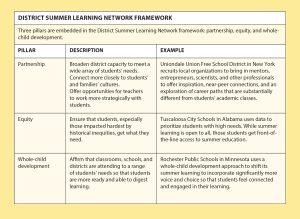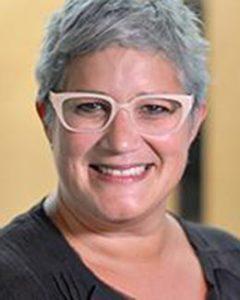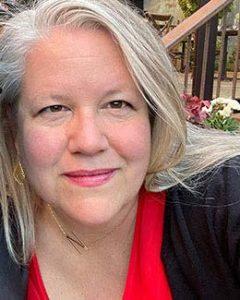FOCUS
Reimagine summer to accelerate learning
By Risa Sackman and Nancy Gannon
Categories: Collaboration, Improvement science/networks, Learning systems/planningJune 2023
Most people associate summer with activities that have nothing to do with school, or, if they do, summer school comes to mind — the remediation variety. Historically, summer school is for struggling students who need to relearn and firm up skills from prior years or for those required to retake a class. With this type of remediation, teachers review content a student may not have mastered from the previous year before moving on to grade-level work.
But what if we could reimagine how to use the summer months to provide effective, engaging learning opportunities for students, especially those who were hit hardest by the pandemic? Some districts are shifting to evidence-based summer programs that move from remediation to acceleration in a climate that prioritizes equity and supports well-being so that all students can thrive.
This article offers a framework for the components of effective acceleration, explains the role of high-quality professional learning, and provides examples of school systems that are making it happen through a summer learning network led by FHI 360, an organization whose education initiatives aim to dismantle obstacles and give students the tools they need to succeed in school. These summer learning approaches are connected with school-year learning, and the lessons we are learning from them have implications for professional learning with and for school-year teaching staff.
Acceleration vs. remediation
Despite the widespread use of remediation, evidence shows that it’s not an effective way to improve students’ performance or get them to grade level. The primary failure of remediation is that it limits the time students spend doing grade-level learning; additionally, remediation is often boring and stigmatizing, which further impedes students’ progress.
In fact, remediation can have detrimental outcomes, including exacerbating inequities (Hill, 2020; North, 2021; TNTP, 2021), because students of color and those from low-income backgrounds are more likely than their white and wealthier peers to experience remediation — even when they have already demonstrated success on grade-level content (TNTP, 2018, 2021).
Learning acceleration is proving to be far more successful than remediation in helping students perform well socially, emotionally, and academically. At the heart of this shift is grade-level learning. Teachers provide scaffolded foundational concepts and skills to students as they need them. This includes exposing students to essential vocabulary and background knowledge on the topics so students can form a deeper understanding of the new information, see its relevance, and take ownership of learning.
Through ongoing formative assessments, the teacher knows exactly what knowledge and skills students have and where there are gaps. This way, there is no need to spend time on content students already know. This type of just-in-time learning is key to students being more engaged and experiencing greater success. Not only does it boost students’ academic progress, but it also improves their confidence, attendance, sense of connection and belonging, as well as college and career readiness.
How the network promotes acceleration
Adding in well-designed and thoughtfully planned accelerated learning between traditional academic school years is no small feat. To do this at scale, FHI 360 partnered with The Wallace Foundation to launch the District Summer Learning Network in January 2022. Through the network, FHI 360 is assisting 100 geographically diverse school districts across the country in their redesign of summer learning programs.
Focused on equity, the network asks districts to rethink which students are invited to summer learning offerings, prioritizing participation based on a needs assessment that integrates test scores, grades, opportunity gaps, and other criteria.
Achieving a radical change in mindset and programming requires a substantial commitment to professional learning for teachers and leaders. We designed our professional learning to be timely and relevant, with the key outcome being the development of a three-year road map that can serve as a guide for districts to implement transformed summer learning programs to improve results for young people.
The network facilitates professional learning with district leaders so they may gain competency and understand systems and strategies to support accelerated learning. Our learning network also supports districts to facilitate professional learning for teachers and staff, who may be required to unlearn things they have done in the past.
Through the network, FHI 360 offers districts three integrated professional learning strands for just-in-time supports and strategies: job-embedded coaching, whole-group sessions, and small learning communities. While there is no one perfect design for professional learning, our team has identified key strategies that can create powerful outcomes: Establish a clear, districtwide vision; consider summer an extension of the school year; prioritize student learning essentials; and develop district leadership for summer programs and beyond.
By incorporating these strategies in ways that fit staff needs, district leaders build educators’ capacity to provide acceleration for students who need it most. In this article, we provide several examples of these components and the professional learning school districts are implementing to accomplish this.
Establish a districtwide vision
If districts want a new paradigm for summer classrooms, they must create opportunities for educators to learn and practice those new moves. For that to happen, leaders need to address the policy and the politics that built the old model.
For Newark Public Schools in New Jersey, that meant that clear expectations and messaging had to come from leadership. The superintendent articulated the importance of challenging all students with grade-level materials. By specifically stating that there would be no remediation or credit recovery, the superintendent provided a strong vision of summer learning as an extension of the larger district commitment to accelerated learning.
With such defined guidelines for everyone — from school principals, to teachers, to learning specialists — there is no room for misinterpretation or error. The clear messaging of learning acceleration vision and priorities communicates to the community that district resources will be allocated toward working on strategies and materials to accelerate student learning and that educators will be expected and supported to learn how to implement it.
Consider summer an extension of the school year
District leaders can work across departments to ensure that summer learning and the professional learning for summer instructors that supports it are seen as integral parts of the school’s work, not a separate project or special initiative. This creates coherence and consistency.
For example, network member Dougherty County School District in Georgia explained to staff the connection between professional learning for school-year and summer instruction, noting that summer instruction is aligned with the rest of the district’s work and that investing in summer professional learning is another way to invest in the overall development of teachers and staff. The superintendent provided a vision of systems and structures to promote a seamless cycle of professional learning.
For instance, the team that plans and develops summer acceleration professional learning is the same team that is thinking about what teachers need in the fall. This team starts planning for summer in January, implements three professional learning sessions in the spring for summer instructors, and then integrates what they’ve learned during summer instruction into the fall professional learning for all teachers.
Dougherty’s summer professional learning includes a strand of learning for leaders and aspiring leaders, knowing that their work will be key to consistent school-year implementation across the district. The cycle is continuous, building on itself by all who are engaged in the work.
Professional learning sessions include paraprofessionals, teaching assistants, and other staff so that everyone in the district understands the mission and the implementation strategy around shifting from remediation to acceleration. That shift requires ongoing learning and practice from everyone.
There’s a continuing conversation about what acceleration can look like so that students are engaged and excited about their summer learning. The network provided districts with examples to make this concrete and attainable. In Battle Creek, Michigan, student engagement increased when students were given more voice and choice by creating idea boards to brainstorm what they wanted to study during summer learning. In this way, the students took ownership over their learning.
Prioritize student learning essentials
What is most critical to address in limited professional learning time? As Rochester City School District in New York makes a major shift from a remedial approach in summer, it has started to draw a picture of what accelerated classrooms would look like. The district is identifying the key strengths required for a class to meet the definition of acceleration.
For example, the district is prioritizing writing skills and will use those as a thread throughout the summer. It is looking at student competencies, such as the ability to read grade-level texts, exposure to academic vocabulary, or showing evidence of one’s work. As a first step, some teachers shifted from using worksheets and resources that were below grade level to ones that were on grade, with some strategic supports to enable students to understand and complete the work. As a next step, many staff are planning ways to provide a range of scaffolds for project-based and inquiry-centered activities that are on grade level and serve to ignite students’ interests and help them make real world connections.
These acceleration competencies will drive pedagogical and curriculum priorities, leading the district to prioritize professional learning. If the district wants teachers to shift to require all students to read grade-level texts, professional learning must focus on the skills and strategies educators need to make those classrooms successful.
For summer 2022, Florence School District 3 in South Carolina started summer professional learning in March with a districtwide session that helped staff understand and accept summer programming and created a strong shared set of goals. The first session built buy-in, and the next two sessions targeted teachers who were going to instruct that summer.
Last year’s professional learning focused on whole-child development needs for elementary students, recognizing that students could not thrive academically if their developmental needs were not met. In 2023, the district will expand programming for middle and high school students and design professional learning around those competencies.
Develop district leadership
Newark Public Schools created its 2022 summer professional learning plan with an eye toward using summers to build capacity for acceleration across the district. Knowing the district would lose leaders to retirement, it recruited innovative, aspiring vice principals and teachers to lead summer learning sites.
Both groups participated in months of professional learning focused on the shift from remediation to acceleration. By investing in this group of future leaders, who in turn manage the professional learning for teachers, Newark knew it could strengthen the quality of summer programming while also building capacity and preparing for the decade ahead.
Last year, the entire group collaborated to create a summer learning orientation framework for consistent implementation across the district, with a shared understanding of the purpose and goals for the summer program. Then, individual leads customized that framework in ways that were relevant to their specific sites.
Notably, intensive professional learning happened daily across the sites. Each leadership team (vice principal and teacher to assist) used a walk-through protocol to give ongoing actionable feedback to teachers. This job-embedded professional learning met teachers where they were in their own practice and helped create district coherence.
In its first year in the network, the Newark team focused professional learning primarily on climate and culture. As it moves into its second year, the team’s focus is wholly on academic acceleration. Professional learning will focus on what leaders need to know to pivot from remediation thinking. Those leaders, in turn, will craft professional learning that offers that same path for teachers.
The benefits of summer learning
Professional learning for summer instruction should feel like a benefit to teachers, an investment in their learning, and a strengthening of their craft. It should create the kind of conditions we are asking teachers to nurture in their classrooms: places where learners feel valued, supported, inspired, and set up for success.
Now in our second year, the network’s districts are determined to create accelerated learning opportunities for summer 2023 that will engage more than 2 million students, many of whom are from historically marginalized communities. To do that successfully, network members are building timely, relevant professional learning before and during the summer that supports educators in creating a different and exciting summer learning program for its young people.
References
Hill, P. (2020, April). What post-Katrina New Orleans can teach schools about addressing COVID learning losses. CRPE. crpe.org/what-post-katrina-new-orleans-can-teach-schools-about-addressing-covid-learning-losses/
North, A. (2021, April 23). The debate over how to handle kids’ “lost year” of learning. Vox. www.vox.com/22380650/school-remote-distance-learning-pandemic-covid-19
TNTP. (2018). The opportunity myth. Author. tntp.org/assets/documents/TNTP_The-Opportunity-Myth_Web.pdf
TNTP. (2021, May). Accelerate, don’t remediate. Author. tntp.org/assets/documents/TNTP_Accelerate_Dont_Remediate_FINAL.pdf
Categories: Collaboration, Improvement science/networks, Learning systems/planning
Recent Issues
WHERE TECHNOLOGY CAN TAKE US
April 2024
Technology is both a topic and a tool for professional learning. This...
EVALUATING PROFESSIONAL LEARNING
February 2024
How do you know your professional learning is working? This issue digs...
TAKING THE NEXT STEP
December 2023
Professional learning can open up new roles and challenges and help...
REACHING ALL LEARNERS
October 2023
Both special education and general education teachers need support to help...













